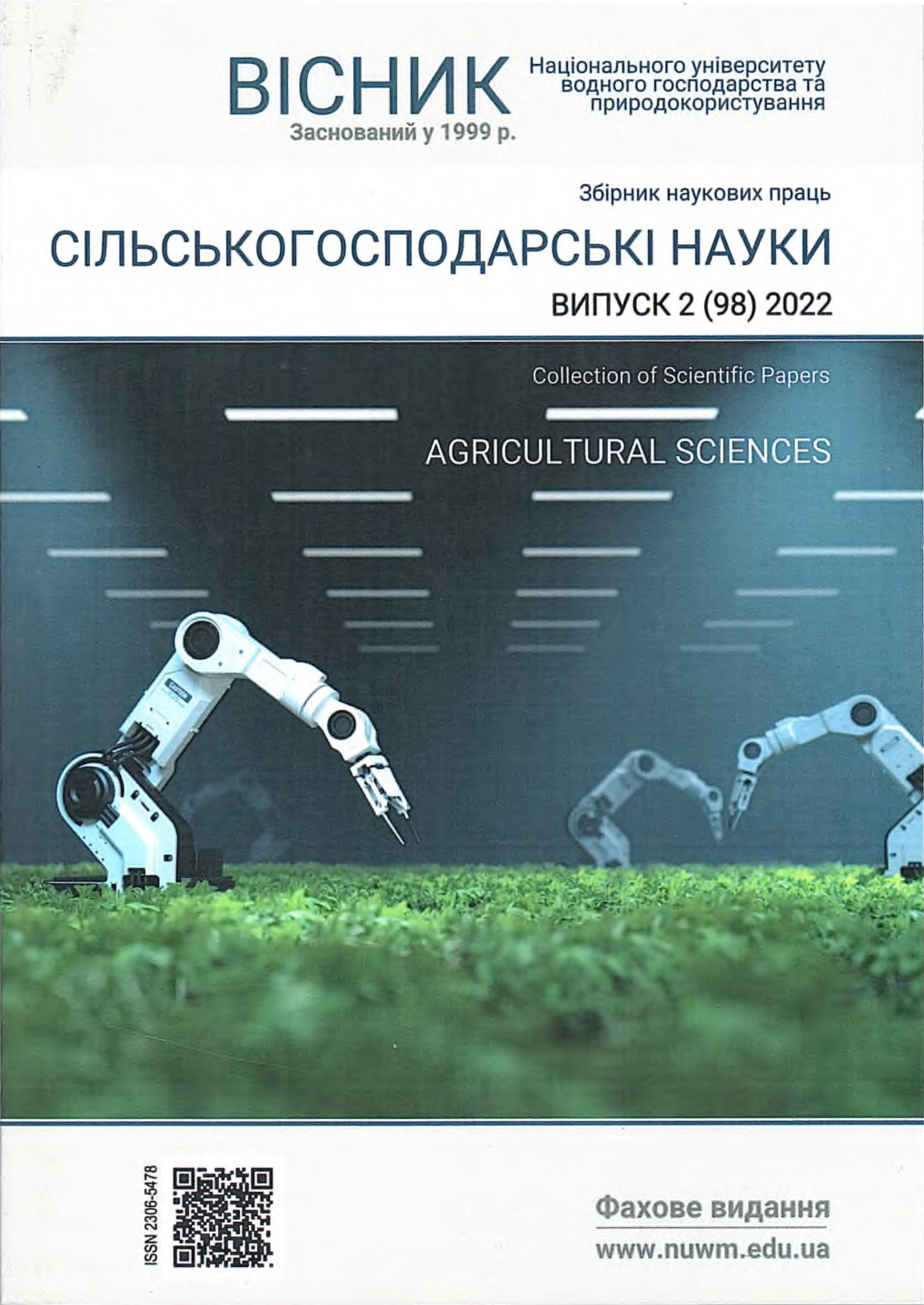SPATIAL VARIABILITY OF SOIL MESOFAUNA DEPENDING ON THE HYDROTHERMAL PROPERTIES OF THE SOIL
DOI:
https://doi.org/10.31713/vs220222Keywords:
Animals of soil participate in most key ecosystem processes and functions. At the same time, anthropogenic interference in the ecosys-tem leads to a decrease or increase in the number of species or frequen-cy of their meeting, which further leads to the rAbstract
Animals of soil participate in most key ecosystem processes and functions. At the same time, anthropogenic interference in the ecosystem leads to a decrease or increase in the number of species or frequency of their meeting, which further leads to the restructuring of the biocenosis structure.The purpose of our research was to determine biomass and quantity of soil mesofauna of sub-regions of the south-eastern part of Volyn Polissya on sections of the forest with different levels of anthropogenic loading. Soil-zoological studies carried out by the method of manual dissolving of soil samples and further determination of the size of biomass and the average number of soil mesofauna. The soil temperature was determined at the site of the research. Soil moisture was determined after delivery of selected samples in the laboratory. All the definitions were performed in three-fold repetition and were subject to statistical processing. The works were carried out on plots of wood, which have one type of soil, cut wood, mainly pine breeds and leaf-wood of natural origin: Site №1 is located near the highway, where the area for picnics is equipped; site №2 is within the limits of the forest, which is not affected by anthropogenic loading; site №3 is the forest area in the first months after the medium intensity fire; site №4 is after the solid felling of forest. Research period – June 2021.In addition, we have noticed that the values of biomass and the number of soils mesofauna, although they differ on sections of the forest with different types of anthropogenic loading, but have no direct relation to the presence or absence of factors of anthropogenic press. In particular, the highest values of biomass of soil animals were characteristic for recreational area (3,78±0,41 g/m2) and area within the forest (2,25±0,71 g/m2), without anthropogenic loading. The analysis of the influence of temperature and moisture of soil on distribution of invertebrates testifies to absence of direct dependence between separately taken factors of hydrothermal regime. However, the joint action of these factors has an obvious influence both on the size of biomass (r=0,81; p=0,009) and on the number of animals (r=0,91; p=0,0004).References
Гиляров М. С. Зоологический метод диагностики почв. М. : Наука, 1965. 281 с.
Пахомов О. С., Кунах О. М. Функціональне різноманіття ґрунтової мезо-фауни заплавних степових лісів в умовах штучного забруднення середовища : монографія. Д. : Вид-во ДНУ, 2005. 204 c.
Симочко В. В., Симочко Л. Ю. Еко-логічний стан мікробного ценозу ґрунту в примагістральних біогеоценозах. Науковий вісник Ужгородського університету. Сер. Біологія. 2009. Вип. 26. С. 148–153. 4. Симочко В. В., Симочко Л. Ю. Мезофауна ґрунту антропогенно трансформованих біогеоценозів. Науковий вісник Ужгородського універси-тету. Сер. Біологія. 2010. Вип. 29. С. 87–92.
Wu P., Wang C. Differences in spatiotemporal dynamics between soil macrofauna and mesofauna communities in forest ecosystems: The significance for soil fauna diversity monitoring. Ge-oderma. 2019. Vol. 337, 2019. P. 266–272.
Киричок Л. Г., Ильенко Н. Н., Бес-кровная Е. В. Структура угруповань мезофауни в захисно-декоративних наса-дженнях на териконах вугільних шахт Донбасу. Вестник зоологии. 2006. № 5. Т. 40. С. 437–443.
Ammer S., Weber K., Abs C., Ammer C., Prietzel J. Factors in-fluencing the distribution and abundance of earthworm communities in pure and converted Scots pine stands. Appl. Soil Ecol. 2006. Vol. 33(1). P. 10–21. 8. Масліко-ва К. П. Екоморфічна структура угруповань ґрунтової мезофауни техноземів Нікопольського марганцеворудного басейну. Biosystems Diversity. 2018. Vol. 26(2). P. 85–91.
Kardol P., Reynolds W. N., Norby R. J., Classen A. T. Climate change effects on soil microarthropod abundance and community structure. Appl. Soil Ecol. 2011. Vol. 47 (1). P. 37–44.
Кунах О. М. Просторова екології ґрунто-вих тварин степового Придніпров’я : дисертація … д-ра біолог. наук : 03.00.16 / Дніпровський національний університет імені Олеся Гончара Міністерства освіти і науки України. Дніпро, 2018. 584 с. URL: https://www.dnu.dp.ua/docs/ndc/dissertations/D08.051.04/dissertation_5b23e462db36e.pdf (дата звернення 29.04.2022).
Практикум з грунтознавства / Ти-хоненко Д. Г., Дегтярьов В. В., Крохін С. В. та ін. Вінниця : Нова книга, 2008. 448 с.
REFERENCES:
Gilyarov M. S. Zoologicheskiy metod diagnostiki pochv. M. : Nauka, 1965.
s.
Pakhomov O. S., Kunakh O. M. Funktsionalne riznomanittia gruntovoi mezofauny zaplavnykh stepovykh lisiv v umovakh shtuchnoho zabrudnennia seredovyshcha : monohrafiia. D. : Vyd-vo DNU, 2005. 204 c.
Symochko V. V., Symochko L. Yu. Ekolohichnyi stan mikrobnoho tsenozu gruntu v pry-mahistralnykh bioheotsenozakh. Naukovyi visnyk Uzhhorodskoho universytetu. Ser. Biolohiia. 2009. Vyp. 26. S. 148–153. 4. Symochko V. V., Symochko L. Yu. Mezofauna gruntu antropohenno transformovanykh bioheotsenoziv. Naukovyi visnyk Uzhhorodskoho universytetu. Ser. Biolohiia. 2010. Vyp. 29. S. 87–92.
Wu P., Wang C. Differences in spatiotemporal dynamics between soil macrofauna and mesofauna communities in forest ecosystems: The significance for soil fauna diversity monitoring. Geoderma. 2019. Vol. 337, 2019.
P. 266–272.
Kyrychok L. H., Ylenko N. N., Beskrovnaia E. V. Struktura uhrupovan mezofauny v zakhysno-dekoratyvnykh nasadzhenniakh na terykonakh vuhilnykh shakht Donbasu. Vestnik zoologii. 2006. № 5. T. 40. S. 437–443.
Ammer S., Weber K., Abs C., Ammer C., Prietzel J. Factors influencing the distri-bution and abundance of earthworm communities in pure and converted Scots pine stands. Appl. Soil Ecol. 2006. Vol. 33(1). P. 10–21. 8. Maslikova K. P. Ekomorfichna struktura uhrupovan gruntovoi mezofauny tekhnozemiv Nikopol-skoho marhantsevorudnoho baseinu. Biosystems Diversity. 2018. Vol. 26(2). P. 85–91.
Kardol P., Reynolds W. N., Norby R. J., Classen A. T. Climate change effects on soil microarthropod abundance and community structure. Appl. Soil Ecol. 2011. Vol. 47 (1). P. 37–44.
Kunakh O. M. Prostorova ekolohii gruntovykh tvaryn stepovoho Prydniprovia : dysertatsiia … d-ra bioloh. nauk : 03.00.16 / Dniprovskyi natsionalnyi univer-sytet imeni Olesia Honchara Ministerstva osvity i nauky Ukrainy. Dnipro, 2018. 584 s. URL: https://www.dnu.dp.ua/docs/ndc/dissertations/D08.051.04/dissertation_5b23e462db36e.pdf (data zvernennia 29.04.2022).
Praktykum z hrunto-znavstva / Tykhonenko D. H., Dehtiarov V. V., Krokhin S. V. ta in. Vinnytsia : Nova knyha, 2008. 448 s.

